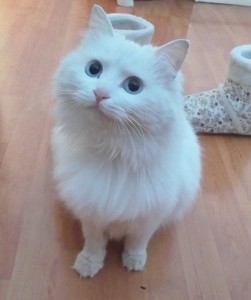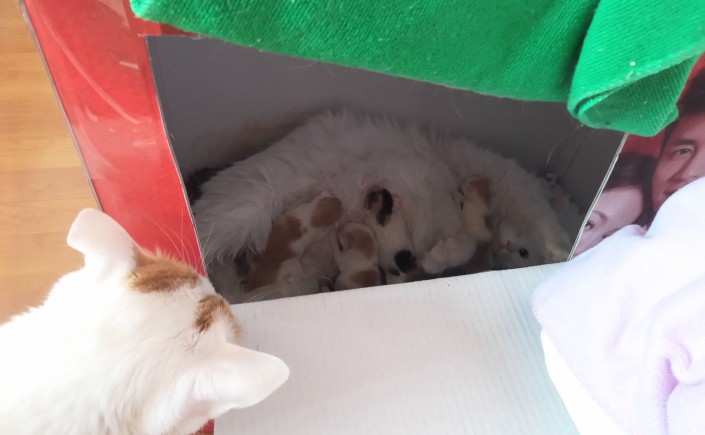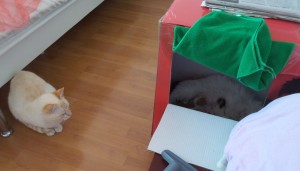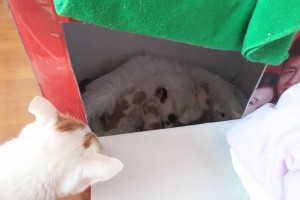For the next nine weeks, follow along with Spot the Kitty as Libby’s kittens grow. Today we’re going to take a look at cat pregnancy. Join us again next week to learn about newborn kittens.

This is Libby a few days before she gave birth. It is difficult to tell from this angle, but her belly was all over the place!
Advertisement: Click here to play Spot the Kitty
Cat Pregnancy at Spot-the-Kitty HQ
Libby was a stray cat we picked up in Beijing, China. She was living in a boarding school grounds, and eating handouts from the children. There is a big holiday in the middle of winter in China, so we took her home for the holiday, hoping to find a new home for her when school came back into session.
A couple of weeks after her arrival, Libby started to show signs of pregnancy — her belly was getting wide, a symptom that cat breeders refer to as “burro belly”, and her nipples were a little pink and slightly swollen because her mammary glands were starting to get ready to produce milk. That’s when we knew our house’s cat population was going to grow. From the point that Libby was starting to show her burro belly, we had five weeks to prepare for the arrival.
Symptoms
Along with burro-belly, other symptoms of kitty pregnancy can include changes in cat behavior — most cats eat more when they are pregnant, of course. They are eating for four or five! Also, some cats become more affectionate in the days before giving birth.
During the last few weeks of pregnancy, you should see your cat exhibiting nesting behavior: looking for a nice secluded, soft place to give birth. Libby walked into every cupboard and closet we opened, checking it out for possibilities.
Preparing for Delivery Day
You should provide a couple of different locations for her to consider. Offer her a large box with a doorway cut into it and an old towel or sweatshirt inside, and put it in an out-of-the-way place in your house. Of course, there is no guarantee that she’ll give birth inside. You might also want to pregnant-cat-proof your house. Make sure there are no little cozy hidey-holes she could get into, like the bit that hangs down under the sofa or a crawl-space under the kitchen cupboards, and keep closets closed. It is also a good idea to keep the doors closed to any rooms you don’t want her giving birth in, like your bedroom or the furnace room.
- We provided a couple of different boxes for Libby, and she chose this one, though she preferred it with the door-flap open so she could show off her kittens.
- Here’s a sneak-peek at the newborn kittens in their kitten box, with Baker peeking in… plotting…
Some people think it’s a good idea to give a pregnant cat milk, but that’s actually really bad for her. Cats can’t digest cow’s milk and it will give her diarrhea, which could lead to dehydration. If you want to enhance your pregnant cat’s nutrition, you can buy special mommy and baby cat food, or pregnant cat supplements. Some pregnant cats will appreciate some egg or some fish added to their diet, too. Some cats experience a bit of morning sickness right about the time they are starting to show. If you find that your cat is not eating or drinking, or has any other troubling symptoms, you should take her to the vet.
Cat Gestation and Pregnancy
Cats have a Y-shaped uterus, with fetuses growing on either side, which is what creates the burro shape. When female cats go into heat, they show obvious signs: your cat will become very vocal as she calls all the male cats in the neighbourhood to come visit, and you might see her crouching down with her butt-end up in the air, waving her tail. She might also leave her scent all around the house, so male cats will be able to sniff her out more easily, by rubbing her face, head, and sides up against everything, and scratching her claws more frequently. Since cats can go into heat and ovulate for about a week, it is quite possible for the kittens in one litter to have different fathers. Cat gestation is nine weeks, so if you know when your cat was mating, you will be able to work out when she will give birth. For more information on cat gestation and pregnancy, look at WebMD.
Join us next time to read about what to expect on delivery day and how you can help your pregnant cat have a comfortable and successful birth.



